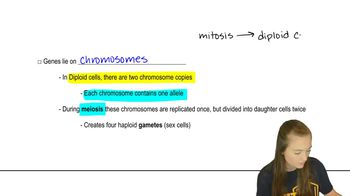Here are the essential concepts you must grasp in order to answer the question correctly.
Biosynthetic Pathways
Biosynthetic pathways are series of enzymatic reactions that lead to the production of complex molecules from simpler ones. In the context of flower pigments, these pathways involve specific enzymes that catalyze the conversion of precursor compounds into pigments, influencing the color of the flowers. Understanding these pathways is crucial for analyzing how mutations in genes can affect pigment production and, consequently, flower color.
Recommended video:
Genetic Inheritance Patterns
Genetic inheritance patterns describe how traits are passed from parents to offspring, often illustrated through Mendelian ratios. In this case, the observed phenotypic ratios in the F₂ generation (9:3:4) suggest a dihybrid cross involving two genes, where one gene may exhibit incomplete dominance or epistasis. Recognizing these patterns helps in predicting the outcomes of genetic crosses and understanding the role of mutant genes.
Recommended video:
Mutant Genes and Phenotypes
Mutant genes are altered versions of normal genes that can lead to changes in phenotype, the observable characteristics of an organism. In the context of the flower color experiment, mutations in specific genes involved in pigment biosynthesis can result in the production of different pigment types, leading to the observed white, pink, and purple flowers. Analyzing how these mutations affect enzymatic activity is key to understanding the resulting phenotypic ratios.
Recommended video:






